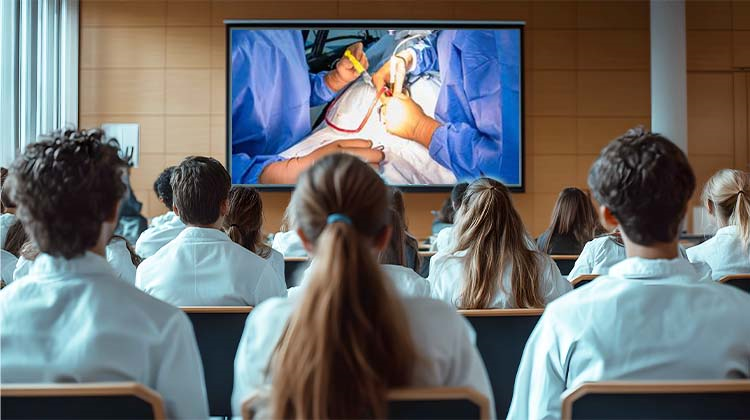Introduction
What was once a closed-off environment, the sterile operating theater is now opening its doors in unprecedented ways. Live surgery broadcast is more than a method of sharing procedures — it is unlocking opportunities for remote surgical education, global collaboration, and, ultimately, better patient outcomes. The real-time broadcasting of surgical video is reshaping how medical knowledge is disseminated and put into practice.
What is Live Surgery Broadcasting?
Live surgery broadcasting refers to the real-time transmission of a surgical procedure from the operating room to an audience located remotely. This technology goes beyond simple video recording — it involves a complex setup of audio-visual equipment, networking, and medical video streaming platforms to deliver high-quality video and audio feeds.
The evolution of surgical video transmission can be traced from early closed-circuit television broadcasts in hospitals to today’s Internet-based video streaming that reaches a global audience. This change has greatly expanded the scope of surgical expertise and promotes a more connected medical community by improving collaboration across borders.
Key Applications of Live Surgery Broadcasting
Live surgery broadcasting is widely used in several professional and educational contexts. Two of the most impactful applications include:
Medical Education

One of the most impactful uses of live surgery broadcast is developing skills for complex, collaborative tasks that are difficult to replicate in real world settings1. Surgical video efficiently enhances medical education and professional development by providing direct, real-time access to intricate procedures. This allows residents, fellows, and practicing surgeons to remotely observe complex techniques, glean insights, and stay updated on the latest advancements.
Platforms like BroadcastMed facilitate this by allowing for more standardized and widespread training. For a trainee, watching a master surgeon at work is a fantastic learning opportunity. It’s not just about the dexterity on display — it’s about picking up on how they make tough calls, understanding the flow of the operation, and seeing how they handle unexpected problems as they happen.
Real-Time Collaboration
Beyond remote surgical education, live surgery broadcasting is a powerful catalyst for real-time collaboration among surgeons and healthcare professionals. Across continents, surgeons can consult on challenging cases remotely and even participate in joint procedures. This promotes a global community of practice, all with the shared goal of improving patient care and disseminating the most effective techniques. The platform Proximie is designed for real-time surgical collaboration, consultation, and remote assistance, making it an ideal platform for hospitals looking to bring in expertise regardless of geography.
Remote consultants can watch surgical videos and provide second opinions, contributing to better-informed decisions and improved patient outcomes. In complex or rare medical cases — particularly in facilities without immediate access to subspecialists — live-streamed surgery can provide critical access to expert guidance and support. In situations where a patient’s condition is complex or a rare disease is involved, live surgery broadcasting can connect local teams with experts around the world, ensuring the patient receives the best possible care.
Technology Behind Live Surgery Broadcast
The effectiveness of HD and 4K surgical video transmission hinges on the underlying technology. Key components include:
- Endoscopic Systems and Surgical Imaging Devices: High-quality imaging is crucial for capturing detailed surgical views. Modern endoscopic systems provide increasingly high-resolution images, and specialized surgical imaging devices offer even more detailed views of specific tissues and structures.
- PTZ Cameras/4K Medical Cameras: Cameras like AVer’s MD120UI provide the image quality needed for high-definition surgical video transmission. These advanced 4K medical grade cameras empower remote viewers with multi-angle views of the surgical field and options to zoom in on areas of particular interest. In addition, the MD120UI features a built-in microphone, ensuring that both visuals and audio are captured clearly for a more immersive and informative viewing experience.
- AV Integration Tools: For seamless transmission, devices like the Barco NRG-220 manage and process the video and audio signals. These tools keep the video and audio signals synchronized and matched in high quality.
- Streaming Platforms: Specialized streaming platforms for medical video, such as Barco NexxisLive, are the conduits through which surgical video reaches remote audiences. These medical video streaming platforms securely deliver content to protect patient privacy, while also ensuring reliable, uninterrupted broadcasts.
Future Directions
Further advances in integrating AI and machine learning are likely to shape further advances in live surgery broadcasts. These capabilities could be used to supercharge the learning experience, for example, by automatically identifying key anatomical structures or surgical steps. Integrating virtual reality surgical training2 (VR) and augmented reality (AR) could overlay the surgeon’s real-time view with crucial additional information while also allowing remote observers to see virtual annotations directly onto the surgical field.
Conclusion
Live surgery broadcasting plays an important role in fundamentally augmenting how surgical education is delivered remotely and enabling global collaboration among surgeons to improve patient outcomes. The continuous advancement of high-quality visual technology is vital for the continued efficacy of live streaming surgery. Beyond disseminating knowledge and skills, surgical video technology fosters a worldwide community of surgeons who can collectively advance surgical care for patients everywhere.
Refer to AVer’s range of cutting-edge AI-enhanced cameras for more.
References
Moskaliuk, Johannes, Johanna Bertram, and Ulrike Cress. 2013. “Impact of Virtual Training Environments on the Acquisition and Transfer of Knowledge.” Cyberpsychology Behavior and Social Networking 16 (3): 210–14. https://doi.org/10.1089/cyber.2012.0416. ↑
Gandsas, Alejandro, Trevor Dorey, and Adrian Park. 2023. “Immersive Live Streaming of Surgery Using 360-Degree Video to Head-Mounted Virtual Reality Devices: A New Paradigm in Surgical Education.” Surgical Innovation 30 (4): 486–92. https://doi.org/10.1177/15533506231165828. ↑